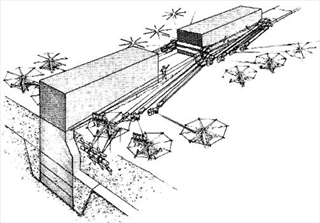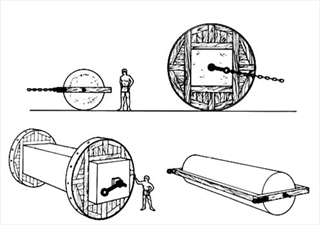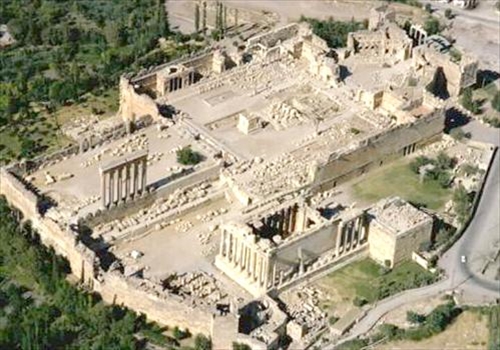 The Ruins of Baalbek
The Ruins of BaalbekThe Ruins of Baalbek, also known as Baalbeck
(1), is a town in the Beqaa Valley of Lebanon east of the Litani River.
(2) The history of settlement in the area dates back some 9,000 years. After Alexander the Great conquered the near east in 334 BCE, the existing settlement, (Baalbek) was renamed Heliopolis.
(3) In Greek, this means sun city. The city retained its religious function during GrecoRoman times, when the sanctuary of the Heliopolitan Jupiter-Baal was a pilgrimage site. Emperor Trajan is reported to have consulted the oracle there. Trajan inquired whether he would return alive from his war with the Parthians. In reply, the oracle presented him with a vine shoot cut into pieces.
Starting in the last quarter of the first century BCE (reign of Augustus) and over a period of two centuries (reign of Philip the Arab), the Romans had built a temple complex in Baalbek of three temples: Jupiter, Bacchus, and Venus. On a nearby hill, they built a fourth temple dedicated to Mercury. The city, then known as Heliopolis, was made a colony by Septimius Severus in 193 BCE,
(1) having been part of the territory of Berytus on the Phoenician coast since 15 BCE. The largest religious building in the entire Roman empire, dates from the reign of Septimius Severus (193-211 BCE), whose coins first show the two temples. Severus conferred the rights of the ius Italicum (governed under Roman rather than local or Hellenistic law, all those born in the city automatically gained Roman citizenship) on the city. The greatest of the three temples was Jupiter Baal,
(5) and was constructed circa 60 BCE.
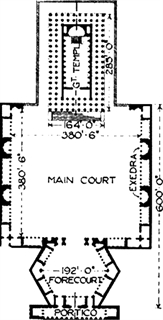
With it were associated two temples, one to Venus, and a lesser temple in honor of Bacchus. It is the best preserved Roman temple in the world. It is surrounded by 42 columns some 20 meters in height. So three Eastern deities were worshiped in Roman guise: the god of storms stood in for Baal-Hadad, Venus for ÔAshart and Bacchus for Anatolian Dionysus. There were 54 columns in the original Jupiter temple. The lintel and frieze blocks weigh up to 60 tons each and one corner block over 100 tons, all of them raised to a height of 62.34° above the ground. Roman cranes were not capable of lifting stones this heavy. By combining multiple cranes they may have been able to lift them to this height. They may have used the cranes to lever one side up a little at a time and use shims while they did the other side. Roman construction was built on top of earlier ruins and the creation of an immense raised plaza onto which the actual buildings were placed. The sloped terrain required the creation of retaining walls on the North, South and West sides of the plaza. These walls were built of about 24 monoliths at their lowest level each weighing approximately 300 tons. The Western, tallest, retaining wall has a second course of monoliths and contains the famous Trilithon
(6) which is a row of three stones, each over 19 meters long, 4.3 meters high and 3.6 meters broad, cut from limestone. They weigh about 800 tons each.
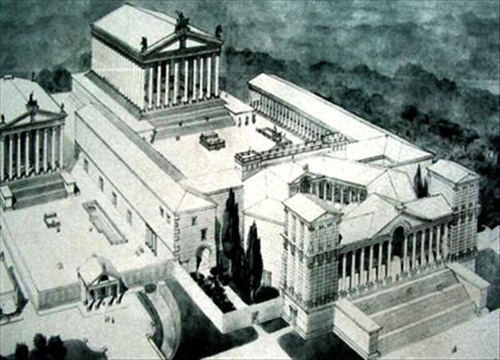
Other emperors enriched the sanctuary of Heliopolitan Jupiter each in turn. Nero (54 -68 BCE) built the tower altar opposite the Temple of Jupiter; Trajan (98 BCE–117 BCE) added the forecourt to the Temple of Jupiter, with porticos of pink granite brought from Aswan in Egypt. Antoninus Pius (138-161 BCE) built the Temple of Bacchus
(7), the best preserved of the sanctuary's structures, for it was protected by the rubble of the site's ruins. It is enriched with refined reliefs and sculpture. Septimius Severus (193 – 211 BCE) added a pentagonal temple of Venus. Emperor Philip the Arab (244 – 249 BCE) was the last to add a monument at Heliopolis; the hexagonal forecourt. When finished Heliopolis is one of two largest sanctuaries in the Western world.
The quarry that most of the stones came from is slightly higher up than the temple, no lifting was required to move the stones some 800 meters to the temple. Jean-Pierre Adam made a brief study in 1977
(8)suggesting the large stones could have been moved on rollers with machines using capstans and pulley blocks. He theorized he could use 512 workers to move a 557 ton block. Adam suggested that the maritime technology that may have been used came from a pre-Roman era. The Egyptians knew about the pulley so, it is not unreasonable to attribute the construction to a sea-faring people, maybe the Phoenicians or the Minoans.
